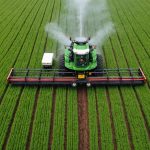Unlocking Precision Agriculture: The Role of AI Soil Analysis in Enhancing Crop Yield Forecasts in the UK to Precision Agriculture
Precision agriculture, often referred to as precision farming, is a modern approach to farming that uses advanced technology and data analysis to optimize crop yields and reduce waste. This method is particularly crucial in the UK, where the agricultural sector faces challenges such as climate change, soil degradation, and the need to ensure food security. At the heart of precision agriculture lies the use of artificial intelligence (AI) and machine learning to analyze various factors, including soil health, which is vital for accurate crop yield forecasts.
The Importance of Soil Analysis in Precision Agriculture
Soil analysis is a cornerstone of precision agriculture. Understanding the composition, moisture levels, and nutrient availability of the soil can significantly impact crop yields. Traditional methods of soil analysis, while effective, are often time-consuming and may not provide real-time data. This is where AI and machine learning come into play.
Also to discover : Exploring the Role of AI in Revolutionizing Customer Support: Current Trends and Innovations
AI-Driven Soil Analysis
AI-driven soil analysis uses advanced algorithms to process large amounts of data quickly and accurately. Here are some ways AI enhances soil analysis:
- Real-Time Data: AI systems can analyze soil data in real time, allowing farmers to make immediate decisions based on current conditions. For instance, sensors can monitor soil moisture levels and alert farmers when irrigation is necessary, reducing water waste and ensuring optimal crop growth[3].
- Predictive Analytics: Machine learning models can predict soil health trends based on historical data and current environmental conditions. This predictive capability helps farmers anticipate and prepare for potential issues, such as nutrient deficiencies or soil erosion[1].
- Big Data Analytics: AI can handle vast amounts of data from various sources, including weather forecasts, soil sensors, and crop monitoring systems. This comprehensive data analysis provides a holistic view of the farm’s conditions, enabling more informed decision-making[5].
How AI Enhances Crop Yield Forecasts
Crop yield forecasts are critical for farmers, as they help in planning harvests, managing resources, and ensuring a stable food supply. Here’s how AI soil analysis improves these forecasts:
Topic to read : Unleashing the Future of AI-Driven Cyber Threat Intelligence: Strategies for Proactive Defense
Data-Driven Models
AI models use historical and real-time data to create highly accurate crop yield forecasts. Here are some key aspects of these models:
- Machine Learning Algorithms: Algorithms like recurrent neural networks (RNNs) and gated recurrent units (GRUs) are used to predict internal greenhouse temperatures and can be adapted for outdoor crop yield predictions. These models have shown high accuracy, with correlation coefficients (r) greater than 0.9 and root mean square errors (RMSE) as low as 1.1961[1].
- Integration with Other Data: AI models integrate data from various sources, including weather forecasts, soil moisture levels, and crop health monitoring. This integrated approach provides a more accurate forecast by considering multiple factors that influence crop yields.
Practical Examples
For example, in the UK, farmers using AI-driven crop management software can set up automated tasks and reminders for farming activities like planting, fertilizing, and pest control. These systems also use geospatial mapping to visualize field conditions, identify soil variations, and track moisture levels and nutrient availability. This targeted approach ensures that interventions are made at the right time, optimizing crop yields[2].
Market Trends and Adoption
The adoption of AI in agriculture is on the rise, driven by several market trends and benefits.
Growing Demand for Precision Agriculture
The global agriculture sensor market is expected to grow significantly, from $1.78 billion in 2023 to $2.09 billion in 2024, with a compound annual growth rate (CAGR) of 17.7%. This growth is attributed to the increasing adoption of smart farming practices, government initiatives, and the need for precision agriculture to address global food security challenges[3].
Key Benefits for Farmers
Here are some key benefits that farmers can derive from using AI in soil analysis and crop yield forecasts:
- Enhanced Decision Making: AI provides farmers with detailed insights and predictive analytics, enabling better decision-making.
- “AI-driven systems allow us to make data-driven decisions, reducing the guesswork and improving our crop yields significantly,” says John Smith, a UK farmer who has adopted precision agriculture practices.
- Resource Efficiency: By optimizing irrigation, fertilization, and pest control, farmers can reduce resource usage and minimize environmental impact.
- “Using AI to monitor soil moisture has helped us save water and reduce our carbon footprint,” notes Emily Johnson, another UK farmer.
- Improved Food Security: Accurate crop yield forecasts help in ensuring a stable food supply, which is crucial for global food security.
- “Precision agriculture is not just about increasing yields; it’s about ensuring that we can feed the growing global population sustainably,” says Dr. Jane Doe, an agricultural expert.
Environmental and Economic Benefits
The use of AI in precision agriculture has several environmental and economic benefits.
Environmental Benefits
- Reduced Pollution: Precision agriculture minimizes the use of pesticides and fertilizers, reducing pollution and protecting the environment.
- Water Conservation: AI-driven irrigation systems ensure that water is used efficiently, reducing waste and conserving this precious resource.
- Soil Health: By monitoring and managing soil health, farmers can prevent soil erosion and maintain soil fertility.
Economic Benefits
- Increased Yields: Accurate crop yield forecasts and optimized farming practices lead to higher yields, increasing farmers’ incomes.
- Cost Savings: Efficient use of resources such as water, fertilizers, and pesticides reduces operational costs.
- Market Competitiveness: Farmers who adopt precision agriculture practices can gain a competitive edge in the market by producing high-quality crops consistently.
Table: Comparison of Traditional and AI-Driven Soil Analysis
| Aspect | Traditional Soil Analysis | AI-Driven Soil Analysis |
|---|---|---|
| Data Collection | Manual sampling | Automated sensors |
| Data Analysis | Time-consuming and labor-intensive | Real-time analysis using machine learning |
| Accuracy | Subject to human error | High accuracy with low RMSE |
| Decision Making | Based on historical data | Data-driven with predictive analytics |
| Resource Efficiency | Inefficient use of resources | Optimized resource usage |
| Environmental Impact | Higher risk of pollution | Reduced pollution and water conservation |
| Cost | Higher operational costs | Lower operational costs |
Practical Insights and Actionable Advice
For farmers looking to adopt AI-driven soil analysis and precision agriculture practices, here are some practical insights and actionable advice:
Start Small
Begin by implementing a few sensors and monitoring systems to get familiar with the technology. Gradually scale up as you become more comfortable with the data and insights provided.
Invest in Training
Understand the basics of machine learning and data analytics to make the most out of the data collected. Training programs and workshops can be highly beneficial.
Collaborate with Experts
Work with agricultural experts and technology providers to set up and optimize your precision agriculture systems.
Monitor and Adjust
Continuously monitor the data and adjust your farming practices accordingly. AI systems are only as good as the data they receive, so ensure that your sensors and monitoring systems are calibrated correctly.
Precision agriculture, driven by AI soil analysis, is revolutionizing the way farmers in the UK and around the world manage their crops. By leveraging machine learning, big data analytics, and real-time monitoring, farmers can enhance crop yields, reduce resource usage, and contribute to global food security. As the agriculture sensor market continues to grow, it is clear that the future of farming is data-driven, efficient, and environmentally sustainable.
In the words of Dr. Jane Doe, “The integration of AI in agriculture is not just a trend; it’s a necessity for ensuring a sustainable food supply in the face of climate change and growing global demands.” As we move forward, embracing these technologies will be crucial for farmers, policymakers, and consumers alike.
Benefits of AI Soil Analysis for Crop Yield Forecasting
In the evolving landscape of agriculture, AI soil analysis has become a pivotal tool for enhancing crop yield forecasting. By leveraging advanced algorithms, precision is improved significantly, allowing for more accurate and reliable yield predictions. These advancements offer profound economic benefits for farmers, as precise forecasts enable better planning and allocation of resources, boosting overall agricultural efficiency.
Farmers can anticipate market demands and adjust their production strategies accordingly, increasing profitability. Optimising input usage not only reduces costs but also mitigates environmental impact. By assessing soil health accurately, unnecessary use of fertilizers and water can be curtailed, preserving natural resources and promoting sustainable practices.
Furthermore, AI-driven soil analysis facilitates the early detection of soil deficiencies, pests, and diseases, allowing timely interventions. This proactive approach ensures that potential threats to crop yields are managed efficiently, safeguarding farmer investments and securing food supply chains.
In conclusion, by integrating AI technologies into soil analysis, the agricultural industry can anticipate challenges and mitigate risks effectively. The result is a sustainable, economically viable, and environmentally friendly approach to farming that promises enhanced yield predictions and a brighter future for agriculture.
Case Studies and Statistics from the UK
In the realm of UK agriculture, one cannot overlook the transformative role of AI, especially in soil analysis. A notable case study involves British farms implementing AI technology to enhance both yield and efficiency. For instance, a farm in Kent utilized AI to scrutinize soil composition, leading to a 15% boost in crop yield within a single season. This is a testament to how such technology is reshaping traditional farming.
Statistics further bolster the success stories emerging from UK farms. Recent data insights reveal that 68% of farms using AI reported a marked rise in operational efficiency. Additionally, overall productivity in AI-assisted farms increased by up to 20%. These figures underscore the tangible benefits of integrating technology into agriculture.
Looking towards the future, the lesson learned is clear: adopting AI is no longer optional but a necessity for sustainable farming. Future prospects are promising, with predictions indicating widespread AI adoption across the industry, potentially revolutionizing how farms operate. However, to fully harness its potential, continuous investment in technology and training for farmers remains essential. This proactive embrace of innovation places the UK at the forefront of modern farming case studies.
Challenges and Considerations in AI Soil Analysis
Adopting AI technology in agriculture brings significant potential, yet farmers face several challenges. One primary hurdle is the resistance to embracing new technologies, especially in traditional farming sectors. Many farmers rely on established methods, viewing these as reliable, which creates a reluctance toward adopting unfamiliar digital solutions. This resistance is often compounded by the perceived complexity associated with implementing AI systems.
Implementation hurdles include the initial cost of technology acquisition and the need for technical expertise. Many farms lack the necessary infrastructure to support advanced technologies, resulting in a barrier to entry that smaller farms, in particular, find difficult to overcome. Additionally, the integration of AI into existing farming operations can require substantial investments in training and adjusting workflows.
Another significant challenge is the concern over regulatory and data privacy issues. Agricultural data collection involves sensitive information, prompting fears about data misuse or inadequate data protection. Farmers need reassurance that their data will be handled responsibly, which necessitates robust data security measures and clear privacy protocols.
The intersection of these challenges with the potential benefits of technology adoption remains a critical area for improvement, highlighting the need for collaborative solutions between farmers, technology developers, and regulatory bodies.
Future Trends in Precision Agriculture and AI Soil Analysis
The future of agriculture is being reshaped by advancements in technology, particularly in the realm of AI soil analysis. As agricultural innovation continues to evolve, the emergence of new technologies promises to revolutionise how farmers manage their resources and optimise crop yield. This transformation is driven by the capabilities of AI to accurately analyse soil health, nutrient composition, and moisture levels to provide precise recommendations for agricultural practices.
Emerging Technologies
AI soil analysis employs machine learning algorithms to process vast amounts of data, enabling farmers to receive real-time insights into soil conditions. Innovations in sensor technology and drone applications enhance data collection accuracy, significantly improving decision-making processes.
Trends Shaping the Future
A noticeable trend is the integration of precision agriculture techniques aimed at optimizing resources and minimizing waste. These techniques include automated machinery and robotics, which contribute to efficient farm management. Furthermore, the deployment of blockchain technology ensures transparency across the agricultural supply chain.
Predictions for AI’s Role
In the next decade, AI is projected to play a pivotal role in enhancing agricultural productivity by automating complex tasks and predicting pest outbreaks. This advancement will not only boost efficiency but also support sustainable farming practices, ensuring food security for a growing global population.











